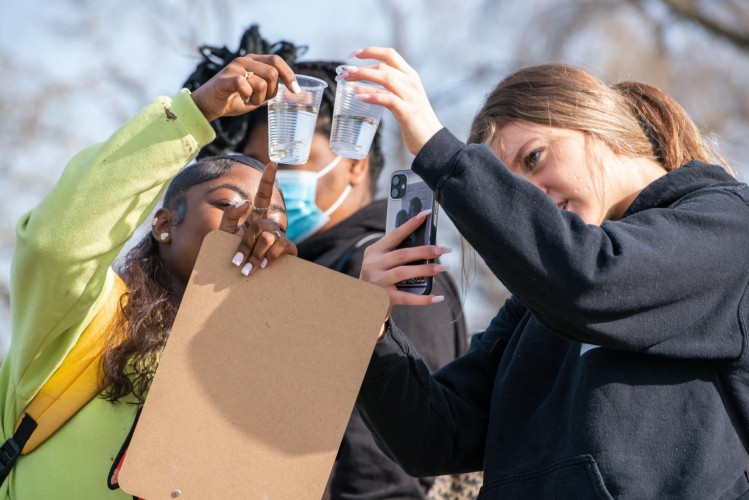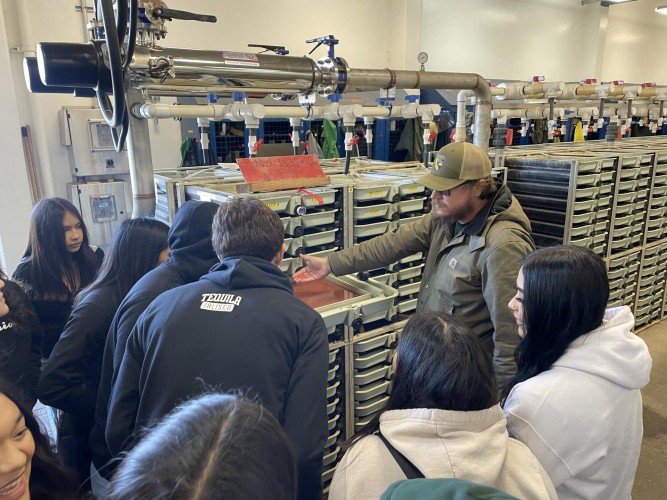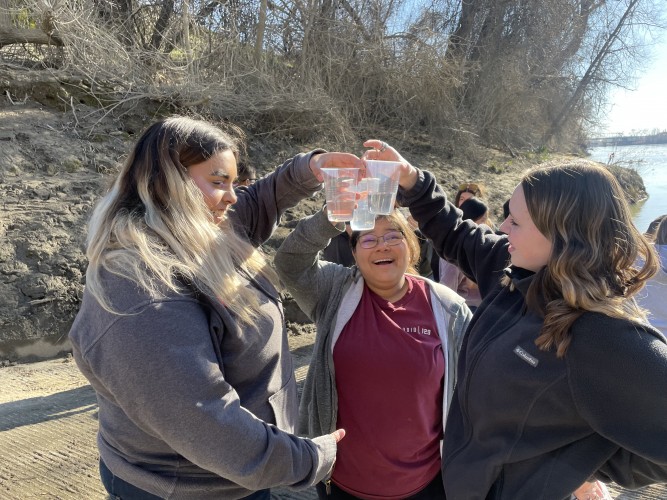Spinning Salmon, Year Three: Deepening our Collaboration and Community Connections
Our Center specializes in helping educators and youth work together on real science – youth-focused community and citizen science. An especially powerful aspect of this approach is the opportunity to help youth connect directly with professional scientists, and with local partners in their own communities who are working on environmental challenges. The story of our Spinning Salmon project shows how these connections can evolve over time, as partnerships develop, and new opportunities for collaboration arise.
 In October we will launch year three
of our Youth-Focused Community and Citizen Science (YCCS)
Spinning Salmon program,
where high school students in Glenn, Tehama, Colusa and Solano
counties will join a 50+ member research team working to
understand the complex puzzle of Thiamine Deficiency Complex
(TDC) impacting California’s Central Valley salmon
populations.
In October we will launch year three
of our Youth-Focused Community and Citizen Science (YCCS)
Spinning Salmon program,
where high school students in Glenn, Tehama, Colusa and Solano
counties will join a 50+ member research team working to
understand the complex puzzle of Thiamine Deficiency Complex
(TDC) impacting California’s Central Valley salmon
populations.
TDC was first documented in California’s salmon in 2020 when hatchery staff noticed offspring swimming in circles and dying at elevated rates. They traced the condition to a deficiency in thiamine, or vitamin B1, passed on from returning adults to their offspring. The Center for Community and Citizen Science (CCCS) was brought on board not long after the initial research team was convened to help develop YCCS data collection protocols and classroom lessons to support students’ submission of high-quality data as part of the Classroom Aquariums Program through the Department of Fish and Wildlife. The data students are submitting is helping the broad coalition of researchers understand the impacts of TDC on these early life stages.
 Connecting Youth Directly With
Research Team, Exploring Career Pathways
through Collaboration with GEAR UP College Opportunity
Program
Connecting Youth Directly With
Research Team, Exploring Career Pathways
through Collaboration with GEAR UP College Opportunity
Program
Year one CCCS collaborated with the College Opportunity Program, GEAR UP: STEM Rural Valley Partnership. Together with the Gear Up team, we aimed to explore ways that professional development for educators and YCCS programming could improve STEM learning and deepen students’ exploration of a wide variety of college and career pathways. Through the collaboration with Gear Up that first year, Gear Up teachers from Glenn, Tehama and Colusa counties were trained using CCCS’s research-based framework for best practices when conducting YCCS programs. Teachers were also trained and permitted by CDFW through the Aquariums in the Classroom Program which allowed each classroom to receive salmon eggs for observation. Students submitted data on behavior and mortality rates of the salmon. Communication with the research team was conducted via Q&A as well as virtual class visits as students were introduced to the collaborating research team. That first year, as the program was built out, the CCCS team recognized what an opportunity this program was, allowing students to have real-time connections to the members of the research team working on TDC.
 Connecting Youth To Local
Environmental Restoration Projects through Collaboration
with Community Based Partners and County Offices of Education
Connecting Youth To Local
Environmental Restoration Projects through Collaboration
with Community Based Partners and County Offices of Education
In year one, we learned that the benefits for youth engagement directly with researchers went both ways, with student questions generating reflection and debate amongst the research team. Knowing, based on our research, the benefit for students when there are direct connections made between student data and current research, we worked to deepen those connections more explicitly in the curriculum and teacher training. Based on teacher and student feedback, we refined the program to support a deepening of student skill building around data submission and data analysis. Thanks to a NOAA B-WET Grant awarded to the Solano County Office of Education, the program expanded to continuation schools throughout Solano County. Now engaging four counties, we began outreach to community-based partners (CBP) working on habitat restoration in Glenn, Tehama, Colusa and Solano counties. This collaboration with local CBPs allowed students to connect the problem of TDC to issues within their own community. By connecting with CPBs working in their local area, students were able to see themselves as part of the solution to a local problem impacting salmon populations throughout the Central Valley. Year two included many field trips for students to deepen their understanding of both the resilience-building happing in their own area, but also learn more about a wide variety of college and career opportunities. It also included in class visits and field engagement with the research team directly, reaffirming for students the authenticity of the program and need for the data they were submitting.
Years One and Two included:
- Teacher training focused on the research-based YCCS framework.
- Student protocols and skill-building to ensure high quality data.
- Lesson development focused on local place-based issues and student sense-making.
- Facilitated collaboration between classrooms and the research team directly.
Year Two also included:
- Connections to community-based partners working on habitat restoration.
- Direct connections to current research with additional supports for student data analysis.
- Field trips with community-based partners and/or members of the research team.
 Year Three: Deepening our
Commitment to Equity and Social Justice- Developing Resources
Designed for Students at the Margins
Year Three: Deepening our
Commitment to Equity and Social Justice- Developing Resources
Designed for Students at the Margins
Community and Citizen Science as a “field” is focused on how people that wouldn’t traditionally qualify as “scientists” are taking up the tools of science to address environmental problems, locally, regionally, and globally. The very premise of this is that traditional power structures in science need to be disrupted to include more voices, more sources of knowledge, more ways of thinking about environmental problems, no more so than youth. CCCS has intentionally recruited teachers working with student populations who are often the least likely to have had authentic environmental stewardship programming and have worked over the last year to refine and revise those student and teacher supports to allow for access within these populations. In thinking about supporting youth agency, we have built in additional opportunity for student voice to be brought to the forefront by building out additional opportunities within the program for youth outreach. Engaging some of the most under-resourced and systems impacted students in our region, by design this program focused on lesson developed utilizing a Universal Design for Learning (UDL) lens to support students as they begin to see themselves as having the power to advocate for change within their own community.
Year Three will include:
- Supports for student outreach and advocacy.
- Resources to support a wider diversity of student needs, including supports for engagement with students supported by a deaf and hard of hearing program.
- Additional ways to engage with students’ funds of knowledge.
- Additional ways for students to express their understanding and engage with the broader problem impacting their local ecological system.
- Additional supports for a variety of ways to engage with content learning.
We are excited to launch this year with both new and returning teachers and students and can’t wait to see where year three takes us.








